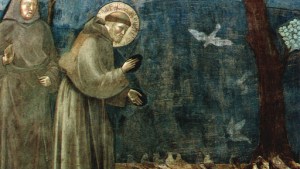By canon law, the numerous religious orders existing within the Catholic Church each wear their own distinctive garb according to the customs and laws of their institute. While it can sometimes be difficult to keep track of them all, the most easily recognizable religious robes may be those coarse brown ones worn by Franciscan friars, which are usually tied with a three-knotted rope, and paired with sandals. We can recognize a Franciscan’s robes from 100 yards away, but how did their brown color become the standard for their order?

Read more:
Listen to the Missa Luba: Congolese liturgical music composed by a Belgian Franciscan
Living simply
Franciscan friars live their lives in solidarity with the poor, taking vows of poverty and living with few possessions. The Rule of St Francis does not prescribe any particular color to the order, but it does invite its members to “wear humble garments,” to “dress in cheap clothing.” The Franciscans serve the poor at their level and it would not help their mission to be covered in finery while serving the destitute.
Earth tones reflect the earthly body
Every order which takes a vow of poverty does so in order to demonstrate that possessions are not what define us, and to follow the words of Christ in Matthew 19:21:
Jesus said to him, “If you wish to be perfect, go, sell what you have and give to [the] poor, and you will have treasure in heaven. Then come, follow me.”
OFM.org, homepage to the Ordo Fratrum Minorum, cites a biographer who mentions the saint’s admiration of the plain lark, suggesting that brown reflects earthly life and the works of the order to relieve earthly suffering:
“Its plumage is earthy. It gives example to religious women and men that they should not have elegant and fine attire, but rather wear dull colors, like that of the earth.”

Read more:
Cappuccino was inspired by 16th-century Catholic friars
In the beginning, brown was all they had
St. Francis began his order about 809 years ago, in 1209. At the time the brothers’ robes were supplied by peasants, who often were not much wealthier than the Franciscans.The most common color worn by the peasant class of the dark ages were varying shades of gray and brown, depending on the source of wool that was used. Undyed cloth was the cheapest available. The robe worn by St. Francis preserved at the Basilica of Our Lady of the Angels is gray. The Franciscans, whose clothing is meant to be utilitarian and long-lasting, were unconcerned by color, but as their influence grew, brown simply became “their color.”
The color served another purpose as well. When the order first began, the brothers lived among the leper colony of Rivo Torto near Assisi, and spent much of their time climbing the mountainous region of Umbria in order to bring relief to the needy. The friars would often sleep in dirt, and the brown color was useful in helping them to still look relatively clean.
The Franciscan Friars of the Renewal, a more recent branch of the followers of Francis, are known for their gray habits.

Read more:
A guide to recognizing religious and monastic habits at first sight
The cincture
Another distinctly Franciscan trait of their garb is the cincture, a long corded rope with three knots tied into it that is worn around the waist. While the cincture does help to keep the sack robes closed on gusty days, the three knots represent Poverty, Chastity and Obedience, the three cornerstones of the Franciscan Order.
The hood
While most Franciscan habits have an attached hood, one branch is distinctive for its long hoods, known as capuches. The Capuchin Franciscans take their name from this distinctive feature, and have in turn given their name to the capuchin monkey (who seems to be wearing a hood) and to cappuccino, the coffee beverage that echoes the coloring of the Franciscan habit.
Visit the slideshow below to discover Giotto’s masterpieces representing the Life of Saint Francis, in the Upper Church of the Basilica Di San Francesco, in Assisi.


